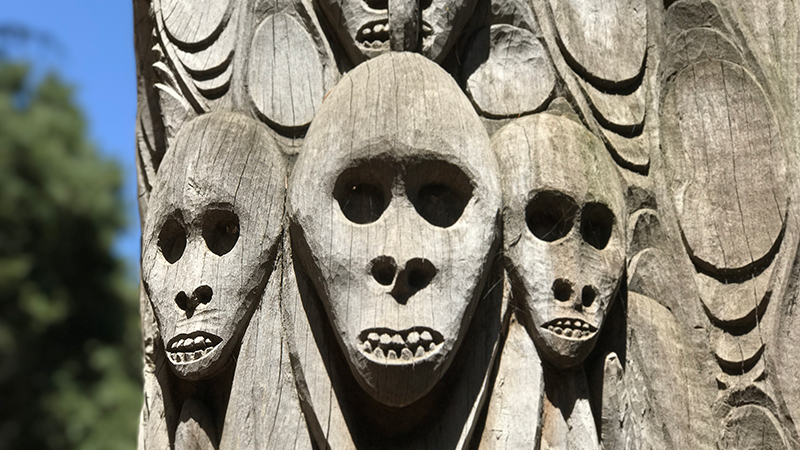
Stanford University is absolutely gorgeous. I had visited the campus in high school for cheerleading camp in the summer, but never had the opportunity to explore the campus. Now with my own daughter entering high school this year and college on the horizon, we wanted to visit the campus and show her what a college campus could be like.
After visiting Mission Santa Clara De Asis and Hoover Tower and checking out the amazing views from the observation deck high above the campus, we still had time to kill before heading over to Shoreline Amphitheater to see Dead & Company. That meant we had time to go exploring and walked all over the campus, peeked into art exhibits, and relaxed in the shade while viewing the carvings in the Papua New Guinea Sculpture Garden.
The New Guinea Sculpture Garden
Sitting in a small, unassuming grove of oak and cedar trees is the Papua New Guinea Sculpture Garden with beautiful carved and painted poles, tall totem-like sculptures, and smaller wood and stone sculptures depicting animals and people.
The shade was a wonderful respite from the blazing summer sun and the periodic benches in the garden provide a place to sit and admire and contemplate the art. While the sculptures and carvings of people were quite interesting, the crocodile and hog wooden carvings and the collection of painted posts were our favorites.
- The crocodile carving and the many crocodile figures found throughout the garden refer to the ancestor Tekwan who wandered the primal water-covered world, guided by a bird on his nose, searching for dry land for humans to populate. Tekwan is understood both as the agent that brought the earth up out of the water as well as the earth itself.
- The painted posts are representative of the main structural posts in Kwoma spirit houses. The figures are abstractions of totemic plants and animals belonging to the clan of the artist, as well as harvest masks and various nature spirits found in the bush around Kwoma villages.
What I also found really interesting were the two Rodin interpretations: The Thinker and The Gates of Hell. Apparently, when artist Teddy Balangu first saw photographs of the Rodin garden during preparations for the Papua New Guinea Sculpture Garden, he said, “This is nothing. We can do better than that.”
- The Thinker relates Rodin’s piece to the story of an ancestor sitting alongside the hole from which he emerged into the world, thinking about how he can create fellow humans out of clay. His first attempt has just failed and the broken body parts are scattered around his feet.
- The Gates of Hell relates the story of a flood which destroys the ancestral world after a man tricks his older brother into killing his wife. The younger brother’s family is depicted on the far side and the twisted bodies on the other are the village people drowning in the flood.
The New Guinea Sculpture Garden Creation
Jim Mason, Project Director and graduate student in anthropology, is responsible for the creation of the New Guinea Sculpture Garden and bringing the artists from the Iatmul and Kwoma societies of the Middle Sepik River region of Papua New Guinea to Stanford.
New Guinea artists have a long and celebrated history of museum exhibition, but rarely have been able to select the works nor the context in which their pieces are presented. The exhibition at Stanford is the direct result of a request by two Kwoma artists who worked with Mason during his anthropological fieldwork on the Sepik River in 1989.
Mason went on to raise more than $250,000 in individual donations, corporate donations, and funds from the National Endowment for the Humanities, Stanford University, and affluent Palo Alto families, and Stanford University provided the Sculpture Garden a permanent site.
In the summer of 1994 ten master carvers ages 27-74 — Naui Saunambui, Yati Latai, Membor Apokiom, David Kaipuk, Gutok Yantaka, David Yamanapi, Yarame Mambegawi, Simon Marmos, Joseph Kandirnbu, and Teddy Balangu — were flown to California. Mason also arranged for several dozen hardwood trees to be shipped directly from New Guinea to the United States and stone to be brought in from Mono Lake.
The four month duration of the on-site carving provided many opportunities for personal interaction and discussion between the master carvers and the local audience at Stanford and several free events were organized throughout their visit, including:
- Daily site tours and discussions with the artists (translators were on site)
- Story time with the artists to hear various myths related to their works
- Musical performances and a weekly lecture series
- New Guinea bark painting classes
During their residency at Stanford, the artists produced a variety of large relief carved poles, free-standing individual figures, painted posts, garamut slit drums, and other large-scale site-specific works. They also collaborated with Kora Korawali, a New Guinea landscape architect, and Wallace Ruff, an American landscape architect, towards generating the site design, landscaping, and display information for the garden.
The idea was not to recreate a traditional New Guinea setting, but to “to experiment with and reinterpret New Guinea aesthetic perspectives within the new context of a Western public art space.”
Know Before You Go
- The Papua New Guinea Sculpture Garden at Stanford University is located in an oak and cedar grove at 476 Lomita Drive, Stanford, California 94305 in Santa Clara County.
- The sculpture garden is small and our visit lasted about 30-45 minutes.
- There isn’t much parking available midweek, but if you arrive early on the weekend, it shouldn’t be a problem.
- Visiting the garden is free.











